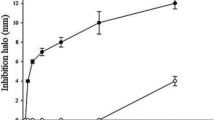Abstract
It is established that bacteria with the ability to produce enzymes hydrolyzing carbohydrates of different complexity degrees are associated with the intestine digestive-transport surfaces of the eelpout Lota lota (L.) and of cestoids Eubothrium rugosum parasitizing in it. The release by bacteria of enzymes hydrolyzing not only complex carbohydrates, but also disaccharides, decreases the energy expenditures of the host and parasite for synthesis of their own hydrolases and increases the glucose concentration near the transport surfaces, which allows all members of this formed community to use glucose. The total amylolytic activity (TAA) of enzymes and the α-amylase activity of the studied bacteria are realized in a wide range of pH values. The levels of the enzyme general amylolytic activity and of bacterial α-amylase activity under the experiment conditions are comparable with similar characteristics of enzymes desorbed from the studied surfaces and participating in the membrane digestion processes in the host and parasite, which can suggest a significant contribution of the symbiotic microflora enzymes to digestion of the host and parasite.
Similar content being viewed by others
References
Ugolev, A.M., Evolyutsiya pishchevareniya i printsipy evolyutsii funktsii (Evolution of Digestion and Principles of Evolution of Functions), Leningrad, 1985.
Pimenov, V.E., Darmov, I.V., Bivalov, A.A., Rudoi, B.A., Chebotarev, E.V., and Roshchevskii, M.P., Actual Problems of the Microorganism Physiology, Zh. Evol. Biokhim. Fiziol., 2004, vol. 40, pp. 180–186.
Austin, B., The Bacterial Microflora of Fish, The Scientific World J., 2002, vol. 2, pp. 558–572.
Shivokene, Ya., Simbiontnoe pishchevarenie u gidrobiontov i nasekomykh (Symbiotic Digestion in Hydrobionts and Insects), Vilnius, 1989.
Cahill, M.M., Bacterial Flora of Fishes: A Review, Microb. Ecol., 1990, vol. 19, pp. 430–435.
Ringou, E., Strom, E., and Tabachek, J.-A., Intestinal Microflora of Salmonids: Review, Aquacult. Res., 1995, vol. 26, pp. 773–789.
Kuzmina, V.V. and Skvortsova, E.G., Bacteria of Gastrointestinal Tract and Their Role in Processes of Digestion in Fish, Usp. Sovr. Biol., 2002, vol. 122, pp. 569–579.
Sugita, H., Kawasaki, J., and Degushi, Y., Production of Amylase by the Intestinal Microflora in Cultured Freshwater Fish, Lett. Appl. Microbiol., 1997, vol. 24, pp. 105–108.
Ringou, E. and Catesoupe, F.-J., Lactic Acid Bacteria in Fish: A Review, Aquaculture, 1998, vol. 160, pp. 177–203.
Izvekova, G.I. and Lapteva, N.A., Microflora Associated with Digestive-Transport Fish Surfaces and with Cestodes Parasited in Them, Ekologiya, 2004, no 3, pp. 205–209.
Izvekova, G.I., Proteolytic Activity of the Microflora Associated with the Digestive-Transport Surfaces of the Eelpout Lota lota and with Eubothrium rugosum Parasitizing in It, Zh. Evol. Biokhim, Fiziol., 2003, vol. 39, pp. 424–429.
Rodina, A.G., Metody vodnoi mikrobiolgii (Methods of the Aquatic Microbiology), Moscow, Leningrad, 1965.
Issledovanie pishchevaritel’nogo apparata u cheloveka (obzor sovremennykh metodov) (Study of the Digestive Apparatus in Human (A Review of the Current Methods), Leningrad, 1969.
Ugolev, A.M. and Kuzmina, V.V., Pishchevaritel’nye protsessy i adaptatsii u rib (Digestive Processes and Adaptations in Fish), St. Petersburg, 1993.
Ringou, E., Olsen, R.E., Mayhew, T.M., and Myklebust, R., Electron Microscopy of the Intestinal Microflora of Fish, Aquaculture, 2003, vol. 227, pp. 395–415.
Kuzmina, V.V. and Kuperman, B.I., A Comparative Characteristic of the Membrane Digestion in Cestodes and Their Hosts—Fish, Parazitol., 1983, vol. 17, pp. 436–442.
Syvokiene, J. and Mickeniene, L., Effects of Heavy Metals on the Bactericenoses of the Digestive Tract of Fish, Chemia i Inzeneria Ekologiczna, 2002, vol. 9, pp. 1033–1038.
Izvekova, G.I., Dynamics of Desorbtion of Carbohydrases from the Fish Intestine Surface and Cestodes Parasitizing in Them, Parazitologiya, 1990, vol. 24, pp. 485–491.
Izvekova, G.I., Content of Proteins, Carbohydrates, and the Glucose Transport at Various Strobila Parts in the Cestode Eubothrium rugosum, Parazitologiya, 1997, vol. 31, pp. 90–96.
Dobrovolskii, A.A., Evlanov, I.A., and Shulman, S.S., The Parasitic Systems: Analysis of the Structure and Strategy Determining Stability, Ekologicheskaya Parazitologiya (Ecological Parasitology), Petrozavodsk, 1994, pp. 5–45.
Krasnoshchekov, G.P., Parazitarnie sistemy. II. Vosproizvodstvo populyatsii i ikh biotsenologicheskie vzaimodeystviya (Parasitic Systems. II. Reproduction of Populations and Their Biocenologic Interactions), Togliatti, 1996.
Author information
Authors and Affiliations
Additional information
Original Russian Text © G. I. Izvekova, 2006, published in Zhurnal Evolyutsionnoi Biokhimii i Fiziologii, 2006, Vol. 42, No. 5, pp. 472–478.
Rights and permissions
About this article
Cite this article
Izvekova, G.I. Trophic interactions in the system host (eelpout Lota lota)—Parasite (Eubothrium rugosum)—Symbiotic microflora at hydrolysis of carbohydrate food components. J Evol Biochem Phys 42, 595–603 (2006). https://doi.org/10.1134/S0022093006050097
Received:
Issue Date:
DOI: https://doi.org/10.1134/S0022093006050097



